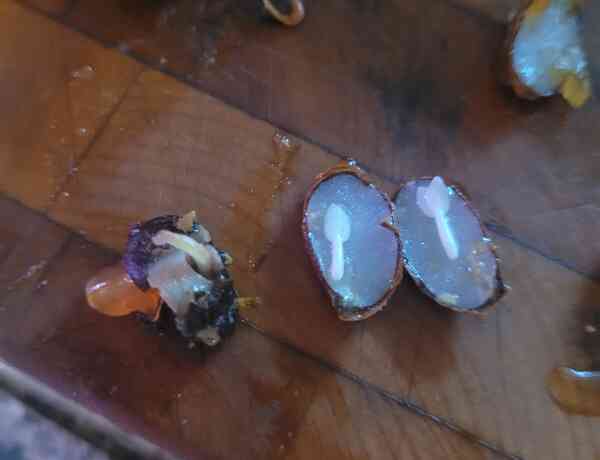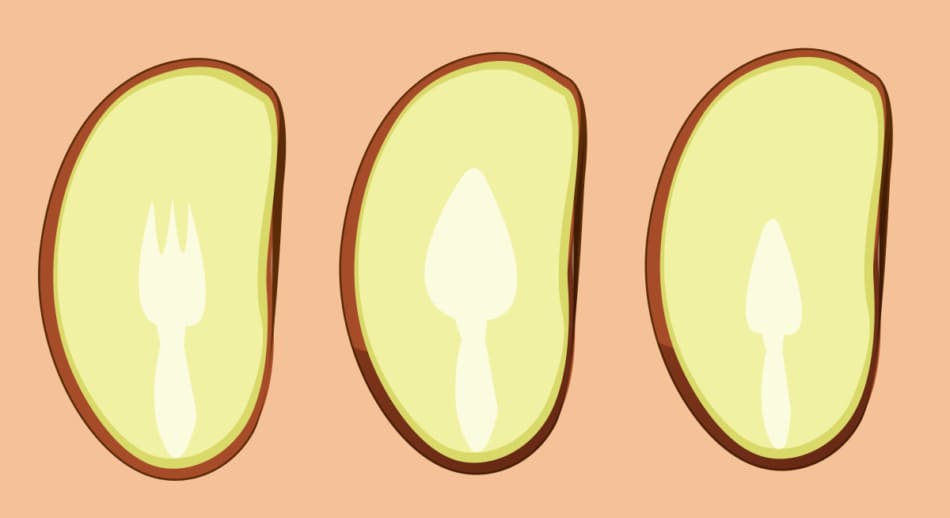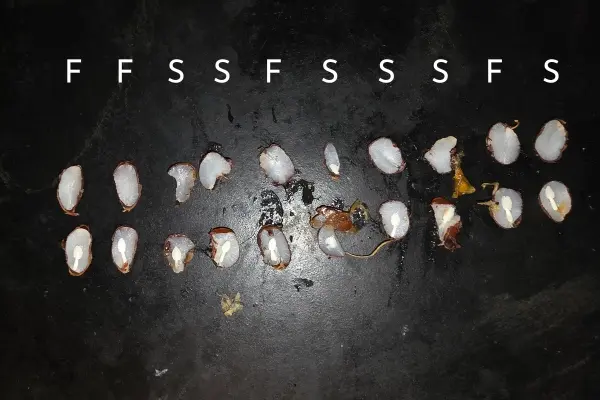Persimmon Seed Weather Prediction 2025-2026

According to popular folklore, persimmon seeds may predict winter weather. How do you make a persimmon forecast? It’s easy. Just split open seeds of a locally grown fruit and look at the patterns inside. What did the persimmon seeds say for 2025-2026? Here’s everything you need to know, including how to make your own persimmon seed prediction:
“Some people believe persimmon seeds can predict the severity of winter weather,” says Farmers’ Almanac Editor, Peter Geiger. “When cut into two pieces, the persimmon seed will display one of three symbols:
- Fork shape indicates a mild winter.
- Spoon shape stands for a shovel to dig out the snow.
- Knife shape means a cold icy winter (where wind will cut through you like a knife).”

Every year, the Farmers’ Almanac speaks with an expert to give readers an authentic prediction of the weather ahead. Wondering if we were correct when we said to expect Snow, Chill, Repeat? Read on to find out …
RELATED: Farmers’ Almanac Official Winter Forecast
Persimmon Seed Prediction 2025-2026
According to The Persimmon Lady’s exclusive report for the Farmers’ Almanac, winter 2025-2026 will be filled with ice, sleet, and snow! Melissa says, “I was really worried this year because the fruits decided to drop early — unripened — and were rotting on the ground. Last time I saw that was in 2018, when we had copious amounts of ice and sleet/snow.” According to the seeds, this matches up! Here is a phot of her seeds:

The first 2 weeks are forks (marked with “F” above), which means “a nice start to the winter season. Then like a rollercoaster we go spoon-spoon, fork, spoon-spoon-spoon, fork, spoon. In other words lots of precipitation with breaks now and then.
We finish out the season with either rain snow or possibly even ice as this is a rather pointed spoon (almost a knife) at the end. Folks, you heard it from the Persimmon Lady herself! Get ready for a Chill, Snow, Repeat!
Who is the Persimmon Lady?
Melissa Bunker, known as “The Persimmon Lady,” has been reading persimmon seeds and making predictions for the Farmers’ Almanac since 2018. Please bear in mind that The Persimmon Lady’s results are relative to North Carolina where she is based. Have any questions for her? Let us know in the comments below …
How To Make Your Own Persimmon Forecast
Choose persimmons from your persimmon tree or local farmers’ market. Be sure that the persimmons come from trees nearby (in order for your forecast to be specific to your location).
Cut open the ripe fruits until you have 10 seeds. (If they are too tough to open, you may soak them in warm water for about one hour first.) The first one you cut open will represent the first week of winter and the second one, the second week of winter (and so on). This is done at random. The final of the ten seeds represents the tenth week of winter.
RELATED: How to Predict Weather with an Onion
Melissa’s Previous Persimmon Seed Predictions
2024 – 2025
Melissa found equal parts spoons, knives, and forks. Translation: “Winter is bound to be a mixed bag. We’re looking at lots of rain, some ice and even some wet snow this year.”
She adds, “The hornets are all over the fruits which tells me they are bulking up for a hard hit from weather. Lots of sugars to hold them over. Common yellow jackets are great indicators [for winter weather as well as persimmon seeds]. If hornets are nesting in the ground it will be mild, but if they are nesting above ground it will be very harsh conditions.”
2023-2024
Melissa said, “It looks like we’re going to have a mild start but don’t be caught off guard because what comes next is 2 knives, which means bitter, ugly cold—possibly even ice events. We then get a small reprieve with fork-spoon-fork. Then another spoon-knife-spoon-knife to finish out the season. It’s definitely going to be cold, cold, cold with some events for snow/ice lovers.”
2022-2023
Melissa opened ten persimmons and only found one seed. This one seed had quite a large shovel shape inside, which called for a snowy winter.
2021-2022
Melissa had 9 forks and 1 knife, which called for a mild winter for North Carolina with one ice event.
Would you like to see more previous persimmon seed predictions? If so, let us know in the comments!
Join The Discussion
Do you believe persimmons can forecast the weather?
Will you make a persimmon forecast this year? We hope you do!
Please share what you find (including photos) in the comments!








Persimmon seed perdition for 2011 in Bartlesville oklahoma
2011 persimmon perdition